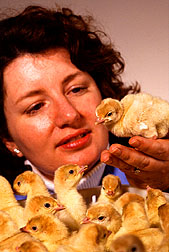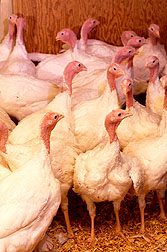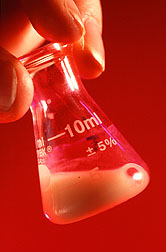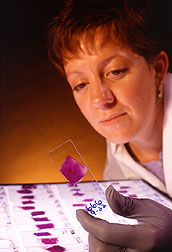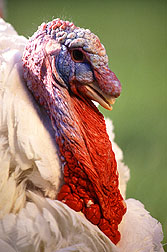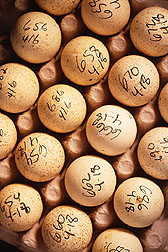Spotting Top-Notch Toms
Since 1863, when Abraham Lincoln first proclaimed the last Thursday of November an official day for giving thanks, Thanksgiving has been synonymous with turkeys.
In recent years, other things have almost become icons of the day: football games, family gatherings, travel, and, of course, leftovers. But while alterations to the Thanksgiving menu have been relatively minor through the years, how the traditional main course--turkey--gets to our tables has changed significantly.
The Pilgrims had to stalk their entree through the wild. Today's production is considerably more high tech. It has to be, to supply the 4.7 billion pounds of turkey that U.S. consumers eat every year--a rate of nearly 18 pounds per person.
Researchers with the Agricultural Research Service in Beltsville, Maryland--birthplace of the historic Beltsville Small White turkey--are helping producers keep pace with this demand and the challenges it poses. At the ARS Germplasm and Gamete Physiology Laboratory, the focus is on improving the reproductive efficiency of turkeys and reducing the problems commercial producers face with turkey fertility and egg production.
A major contributing factor to turkey mating woes is that today's commercial turkey doesn't look much like its early American counterpart, or even its World War II-era ancestor. With advances in genetic selection, adult turkey males, or toms, can weigh up to 85 pounds, whereas a hen weighs around 20 pounds when she begins to lay eggs. This size difference makes natural mating difficult.
|
|
The weight imbalance--plus low fertility of heavy, broad-breasted turkey lines--has prompted almost complete integration of artificial insemination into commercial production.
"We generally have anywhere from 80,000 to 100,000 hens at our hatchery that are artificially inseminated," says Lynn Bagley, director of technical services at the Tarhill Turkey Hatchery in Raeford, North Carolina. "We use thousands of toms to inseminate the hens. We have a few tests to tell whether or not the semen collected is normal or abnormal, but they're very labor intensive."
Animal physiologist David P. Froman of Oregon State University originally developed the test for chickens and, with Donoghue, modified it for use in studying turkeys.
"Essentially 100 percent of the nearly 300 million turkeys produced annually in the United States for consumption are the result of artificial insemination," notes ARS poultry physiologist Ann M. Donoghue, who leads turkey reproductive studies at the Beltsville lab.
|
|
Given the importance of artificial insemination to turkey production, a modern grower might be forgiven for thinking such research achievements overshadow even development of the Beltsville Small White.
A Breakthrough Six Decades Ago
In the 1930s, Beltsville-based researchers William Burrows and Joseph Quinn reported groundbreaking methods for semen collection and artificial insemination for poultry. Those methods are still used today, with a few modifications.
"Artificial insemination in the turkey industry is a very well-established practice," Donoghue says.
"Yet the potential for using this method to select toms that can produce offspring has not been realized. As for managing fertility, there is no test for evaluating semen quickly that is practical for routine use on commercial farms and correlates reliably with fertility."
In another advance, in the 1970s, physiologist Thomas J. Sexton developed the Beltsville Poultry Semen Extender--a solution that dilutes and preserves the sperm outside of the bird's body--that is sold by commercial companies and used worldwide. Sexton is now director of the Beltsville Agricultural Research Center's Livestock and Poultry Sciences Institute.
|
|
Donoghue says artificial insemination of turkeys is considerably more efficient than natural mating, given the sheer number of hens that need to be inseminated. Another plus: With artificial insemination, fewer toms are needed to keep hens producing fertile eggs. Donoghue says the necessary ratio of toms to hens decreases from 1 to 10 with natural mating to 1 to 30 with artificial insemination.
Unlike other production animal systems--dairy cattle, for instance--where artificial insemination is well established, evaluation of individual males in the turkey industry is limited to visual checks of semen color, volume, and concentration of sperm--if evaluation is done at all. The ability to accurately pinpoint sire potential would have tremendous benefits in improved breeding efficiency of turkeys.
"The basis of this test isn't anything new, but we used old ideas in a new way to study the motility of sperm cell populations," says Donoghue.
"Based on studies on turkeys, we found the new information can be used to identify males that are very fertile--or not," she says.
"In the past, most--if not all--semen evaluation tests have been much more effective at picking losers rather than winners. This test does both."
The test could improve the efficiency of picking the best toms, resulting in more fertile eggs with fewer sires. Donoghue and colleagues, with the support of the U.S. Egg and Poultry Association, are planning to take the test to the field for trials in cooperation with the turkey industry.
Since artificial insemination typically involves collecting semen from all toms in a breeder flock, a readily detectable sperm trait strongly associated with fertility could be incorporated into breeder tom management fairly easily. The new sperm motility test is inexpensive, quick, and objective. It requires minimal knowledge or training to perform and could easily be adapted for commercial farm use, according to Donoghue.
"Males with the trait for fast-moving sperm carry that trait through time," she points out. "If the tom is good today, he'll be good tomorrow."
In addition to being able to classify toms as winners or losers, it is also important to understand why and how their sperm differ. By understanding which physiological characteristics influence fertility, sperm from toms classified as losers could potentially be improved.
See How They Swim
Using a computer-assisted sperm analysis system (CASA), Donoghue and colleagues have expanded the knowledge of motility characteristics from different toms' sperm.
CASA tracks and records information as the sperm move across a microscope field. Using a computer to capture the data, several hundred sperm tracks from an individual tom can be analyzed. Scientists in Donoghue's lab have evaluated hundreds of toms using the sperm motility test and CASA.
They found that sperm velocity parameters were consistently higher for toms ranked high by the motility test than for toms ranked lower. These parameters are a way of measuring how fast and in what direction the sperm are moving. Studies are in progress to learn why sperm differ in these characteristics.
The scientists are also trying to determine if additives to sperm--such as caffeine, which has been shown to influence sperm motility in other species--affect sperm from turkeys classified as winners and losers differently.
"Sperm from up to 10 to 15 males are usually pooled for artificial insemination into hens," says Donoghue. "It is generally assumed that sperm from all toms are going to produce similar numbers of offspring, but this is not always the case. Some toms may produce offspring and some may not. So from an economical and practical standpoint, knowing which males' sperm can fertilize eggs and produce offspring is important."
Donoghue, in collaboration with Tuskegee University scientist Edward J. Smith in Alabama and ARS poultry physiologist Murray R. Bakst in Beltsville, inseminated hens with semen from multiple toms and then used DNA fingerprinting to determine the paternity of the offspring. The results were surprising, Donoghue reports.
"When semen from 7 to 10 toms was pooled, we found that only 1 or 2 males produced a majority of the offspring," she notes.
Donoghue says it is possible that sperm motility influences the number of sperm that make it to the sperm storage tubules in the hen and subsequently fertilize the eggs.
"If our hypothesis proves correct," she adds, "the sperm motility test could be adapted and used by the turkey industry as a simple and reproducible objective method for evaluating the male component of fertility.
|
|
"The potential impact of sire selection, based on a test that correlates sperm motility with fertilizing potential, could alter the way breeder toms are managed throughout the United States," she continues. "Simply by sorting out males that are not contributing to offspring production, we estimate a savings of $5 million annually for turkey breeders."
"We generally inseminate each hen with 200-300 million sperm a week," notes Tarhill's Lynn Bageley. "Most of the sperm are pooled from a flock. If we could have a practical way to sort good toms from bad toms, that could mean very big savings. We would be able to reduce the semen dosages to the hens, and it would ultimately cut down on the number of toms we need to maintain to keep our hens in production.
"We're looking forward to any new improvements in the turkey production process."--By Tara Weaver, Agricultural Research Service Information Staff.
Ann M. Donoghue is at the USDA-ARS Germplasm and Gamete Physiology Laboratory, Bldg. 2b2, 10300 Baltimore Ave., Beltsville, MD 20705-2350; phone (301) 504-8580, fax (301) 504-8546.
"Spotting Top-Notch Toms" was published in the July 1998 issue of Agricultural Research magazine. Click here to see this issue's table of contents.








